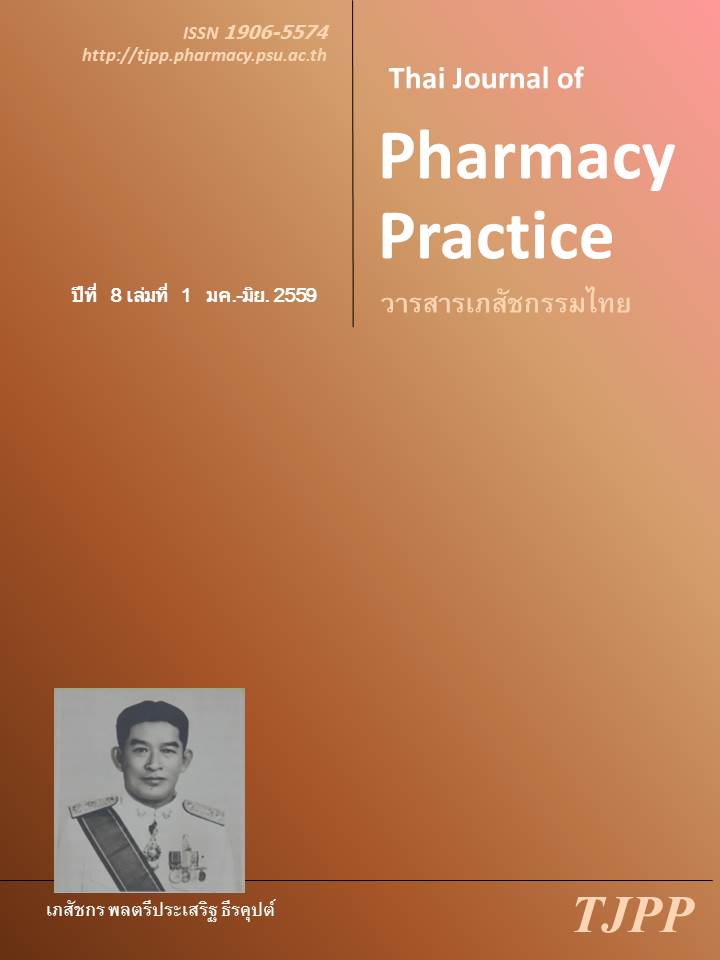ความเข้าใจคำสั่งใช้ยาแบบอัตราส่วนในกลุ่มยาที่มีความเสี่ยงสูงของ พยาบาลวิชาชีพและการคำนวณเพื่อเตรียมยาตามคำสั่งใช้ยา
Main Article Content
บทคัดย่อ
วัตถุประสงค์: เพื่อศึกษาความเข้าใจของพยาบาลวิชาชีพต่อคำสั่งใช้ยากลุ่มที่มีความเสี่ยงสูงซึ่งแพทย์สั่งจ่ายแบบอัตราส่วน ปัจจัยที่สัมพันธ์กับการเข้าใจความหมายของคำสั่งใช้ยาดังกล่าวที่คลาดเคลื่อน และความคลาดเคลื่อนในการคำนวณเพื่อเตรียมยาให้ได้ความเข้มข้นตามคำสั่ง วิธีการ: แบบสอบถามเกี่ยวกับคำสั่งใช้ยาในกลุ่มยาที่มีความเสี่ยงสูงแบบอัตราส่วนถูกส่งให้กับพยาบาล 600 คนที่ปฏิบัติงานในหอผู้ป่วยของ 15 โรงพยาบาลในภูมิภาคต่างๆ ของประเทศไทยระหว่างเดือนตุลาคม 2556–กุมภาพันธ์ 2557 ผลการวิจัย: มีผู้ตอบแบบสอบถามกลับ 517 คน (ร้อยละ 86.2) มีอายุระหว่าง 21–56 ปี อายุเฉลี่ย 34.3+0.7 ปี ปฏิบัติงานในหอผู้ป่วยอายุรกรรม หอผู้ป่วยวิกฤต และหอผู้ป่วยอื่น ๆ ร้อยละ 48.9 ร้อยละ 30 และร้อยละ 21.1 ตามลำดับ ผู้ตอบแบบสอบถามร้อยละ 81.8 เข้าใจความหมายของคำสั่งใช้ยาแบบอัตราส่วนที่พบบ่อยถูกต้องทั้ง 4 ข้อที่ใช้ทดสอบในแบบสอบถาม ปัจจัยที่สัมพันธ์กับการเข้าใจคำสั่งใช้ยาแบบอัตราส่วนคลาดเคลื่อนอย่างน้อย 1 ข้อ คือ หอผู้ป่วยที่ปฏิบัติงาน ผู้ที่ปฏิบัติงานในหอผู้ป่วยอายุรกรรม (adjusted OR 3.19, p = 0.001) และหอผู้ป่วยอื่นๆ (adjusted OR = 4.86, p < 0.001) เข้าใจคำสั่งใช้ยาคลาดเคลื่อนมากกว่าผู้ที่ปฏิบัติงานในหอผู้ป่วยวิกฤต ตัวอย่างเพียงร้อยละ 14.3 เท่านั้นที่สามารถคำนวณการเตรียมยาให้ได้ความเข้มข้นตามที่กำหนดในคำสั่งใช้ยาแบบอัตราส่วน การคำนวณคลาดเคลื่อนมีสาเหตุหลักจากการไม่ได้นำปริมาตรของยามาหักออกจากสารน้ำสำหรับใช้ผสมยา สรุป: การสั่งใช้ยาแบบอัตราส่วนทำให้เกิดความไม่เข้าใจและคำนวณเพื่อเตรียมยาคลาดเคลื่อน ดังนั้น ในการสั่งใช้ยาจึงควรระบุหน่วยให้ชัดเจนเพื่อป้องกันการเกิดความคลาดเคลื่อนอันอาจก่อให้เกิดอันตรายแก่ผู้ป่วย
Article Details
ผลการวิจัยและความคิดเห็นที่ปรากฏในบทความถือเป็นความคิดเห็นและอยู่ในความรับผิดชอบของผู้นิพนธ์ มิใช่ความเห็นหรือความรับผิดชอบของกองบรรณาธิการ หรือคณะเภสัชศาสตร์ มหาวิทยาลัยสงขลานครินทร์ ทั้งนี้ไม่รวมความผิดพลาดอันเกิดจากการพิมพ์ บทความที่ได้รับการเผยแพร่โดยวารสารเภสัชกรรมไทยถือเป็นสิทธิ์ของวารสารฯ
เอกสารอ้างอิง
2. Shane R. Current status of administration of medications. Am J Health-Syst Pharm 2009;66 (suppl 3):s42-8.
3. Parshuram CS, To T, Seto W, Trope A, Koren G, Laupacis A. Systematic evaluation of errors occurring during the preparation of intravenous medication. CMAJ. 2008;178:42–8.
4. Vijayakumar A, Sharon EV, Teena J, Nobil S, Nazeer I. A clinical study on drug-related problems associated with intravenous administration. J Basic Clin Pharm. 2014;5:49–53.
5. Food and Drug Administration. Drug products and narcotics [online] 2015 [cited 2015 Nov 22]. Available from: URL:http://fdaolap.fda.moph.go.th/ logistics/drgdrug/DSerch.asp
6. Gahart BL, Hazareno AR. 2012 Intravenous medications: A handbook for nurses and health professionals. 28th ed. St. Louis (MO): Elsevier Mosby; 2012.
7. Wibulchutikul S, Kunavut P. Some practical points for drug administration in CPR algorithms. In: Kritsanarungsan S, Niruttisart S at al, editors. Handbook of advanced cardiopulmonary resuscitation for health personnel. 2nd ed. Bangkok: A Plus Printing; 2012. p.66-71.
8. Westbrook JI, Rob MI, Woods A, Parry D. Errors in the administration of intravenous medications in hospital and the role of correct procedures and nurse experience. BMJ Qual Saf 2011;20:1027-34.
9. Tissot E, Cornette C, Demoly P, Jacquet M, Barale E, Capellier G. Medication errors at the administration stage in an intensive care unit. Intensive Care Med 1999;25:353-9.
10. Ong WM, Subasyini S. Medication errors in intravenous drug preparation and administration. Med J Malaysia 2013;68:52-7.
11. Cousins DH, Sabatier B, Schmitt C, Hoppe-Tichy T. Medication errors in intravenous drug preparation and administration: a multicenter audit in the UK, Germany and France. Qual Saf Health Care 2005;14:190-5.
12. Abbasinazari M, Talasaz AH, Mousavi Z, Zare-Toranposhti S. Evaluating the frequency of errors in preparation and administration of intravenous medications in orthopedic, general surgery and gastroenterology wards of a teaching hospital in Tehran. Iran J Pharm Res. 2013;12:229–34.


